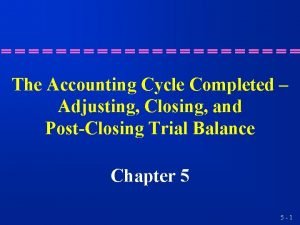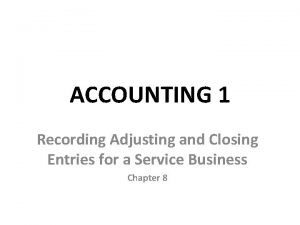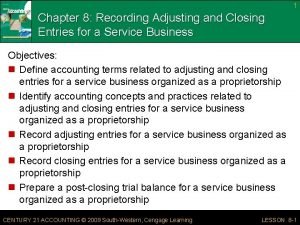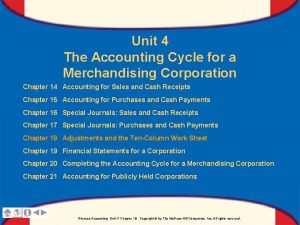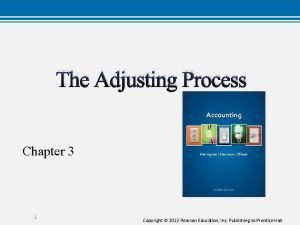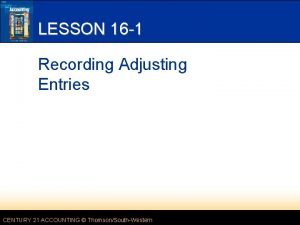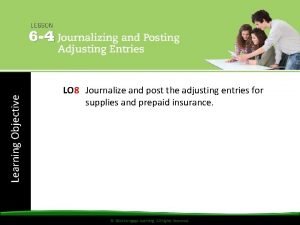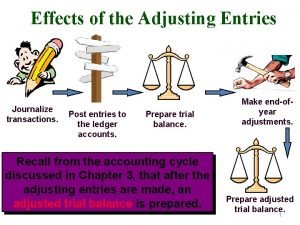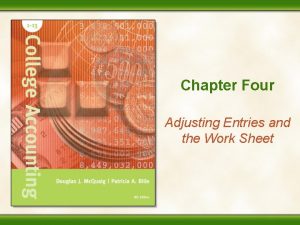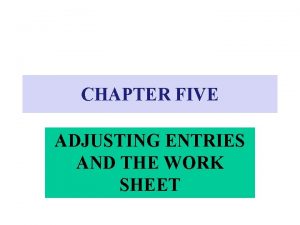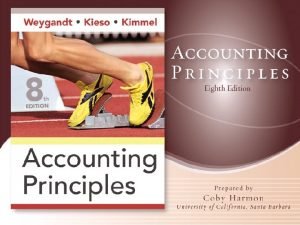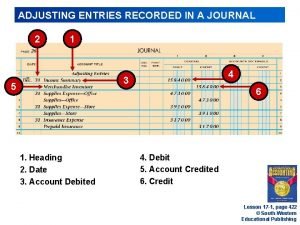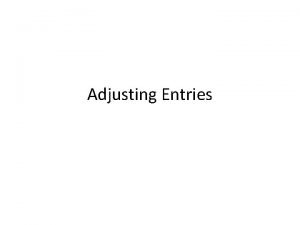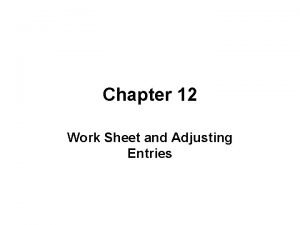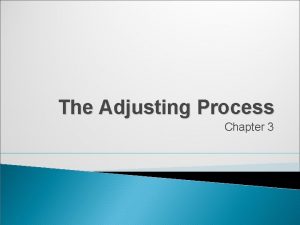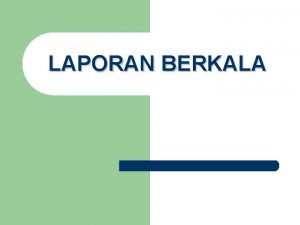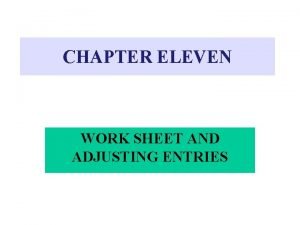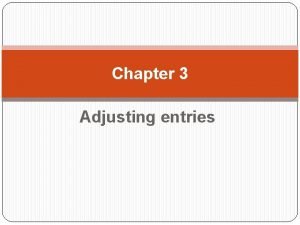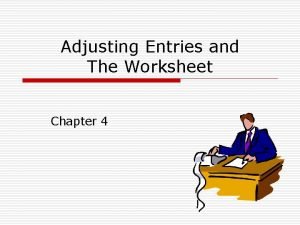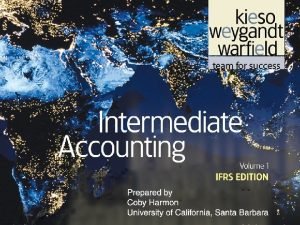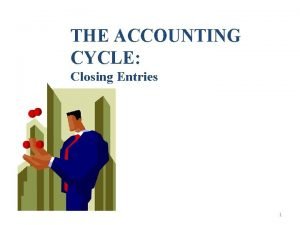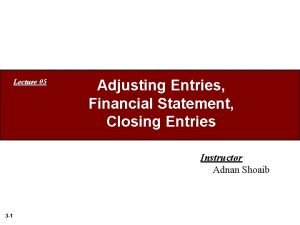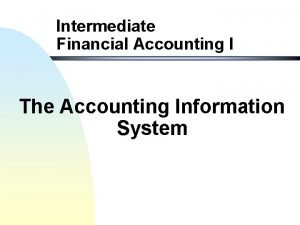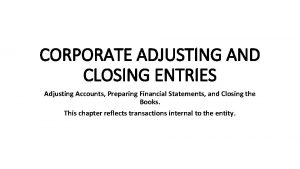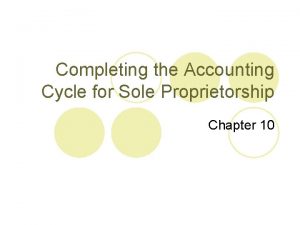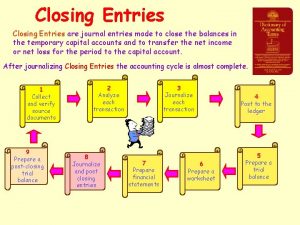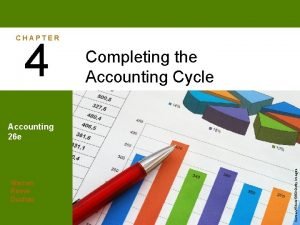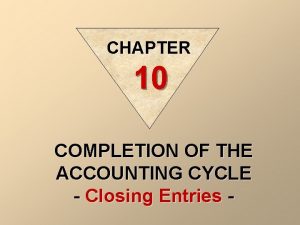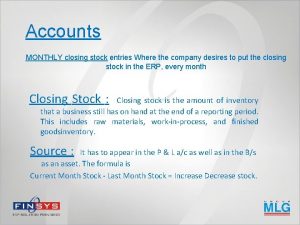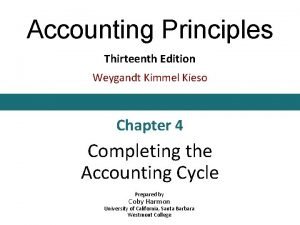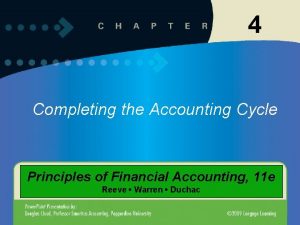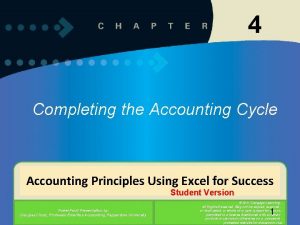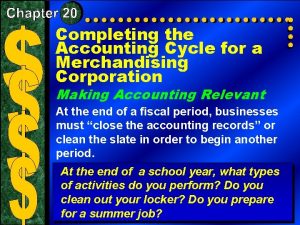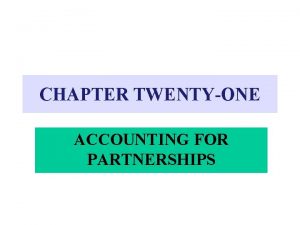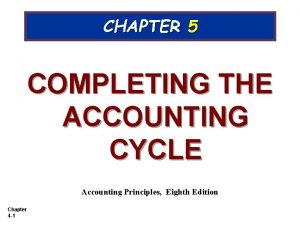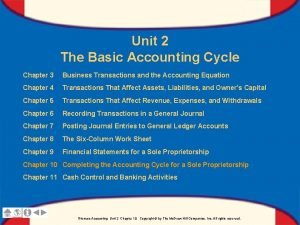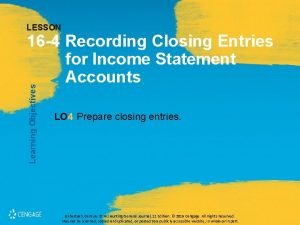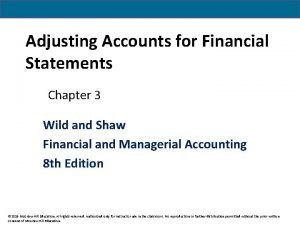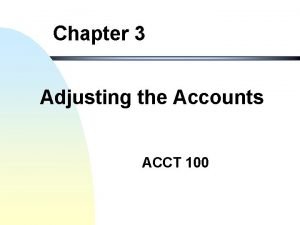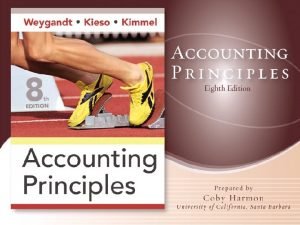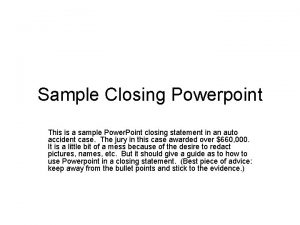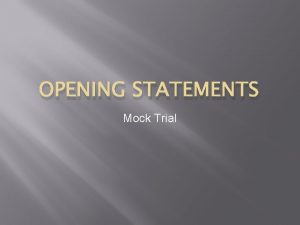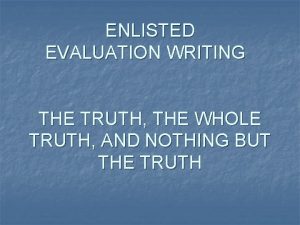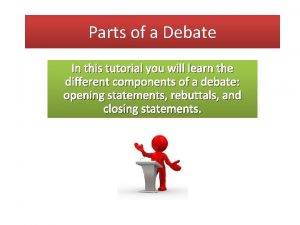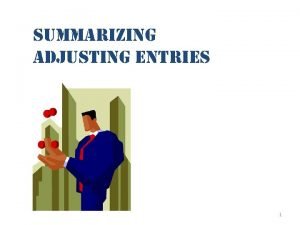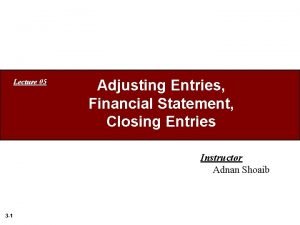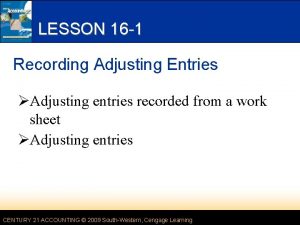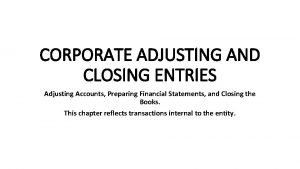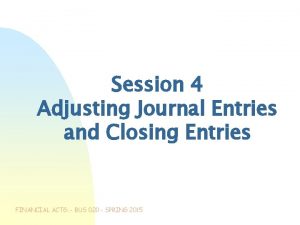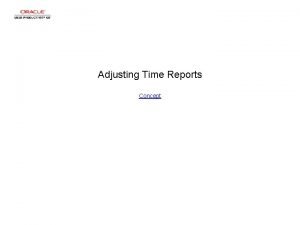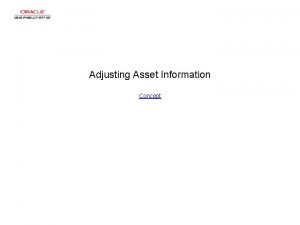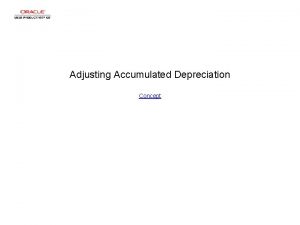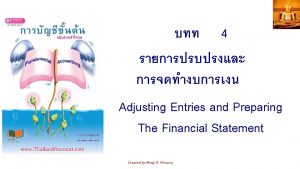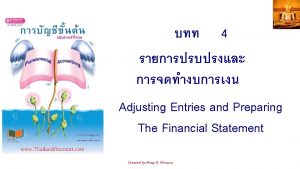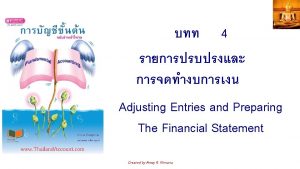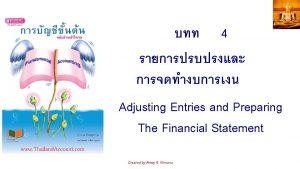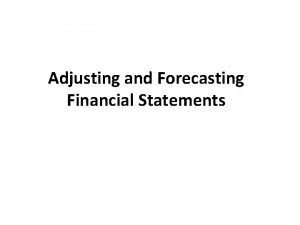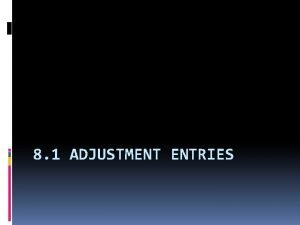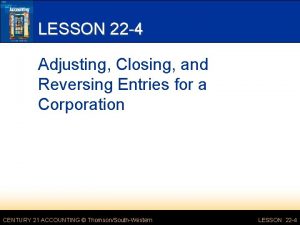Lecture 05 Adjusting Entries Financial Statement Closing Entries



















































- Slides: 51

Lecture 05 Adjusting Entries, Financial Statement, Closing Entries Instructor Adnan Shoaib 3 -1

Learning Objectives 3 -2 1. Explain the reasons for preparing adjusting entries. 2. Prepare financial statement from the adjusted trial balance. 3. Prepare closing entries.

Adjusting Entries for Accruals are either u accrued revenues or u accrued expenses. Illustration 3 -27 3 -3 LO 5 Explain the reasons for preparing adjusting entries.

Adjusting Entries for “Accrued Revenues” Revenues earned but not yet received in cash or recorded. Adjusting entry results in: Revenue Recorded BEFORE Cash Receipt Accrued revenues often occur in regard to: 3 -4 u rent u interest u services performed LO 5 Explain the reasons for preparing adjusting entries.

Adjusting Entries for “Accrued Revenues” Accrued Revenues. In October Pioneer earned $2, 000 for advertising services that it did not bill to clients before October 31. Thus, Pioneer makes the following adjusting entry. Oct. 31 Accounts receivable 2, 000 Service revenue Accounts Receivable Debit 72, 000 74, 000 3 -5 Credit 2, 000 Service Revenue Debit Credit 100, 000 4, 000 2, 000 106, 000 LO 5

Adjusting Entries for “Accrued Revenues” Illustration 3 -35 3 -6 LO 5

Adjusting Entries for “Accrued Expenses” Expenses incurred but not yet paid in cash or recorded. Adjusting entry results in: Expense Recorded BEFORE Cash Payment, if any* Accrued expenses often occur in regard to: 3 -7 u rent u salaries u interest u bad debts* u taxes LO 5 Explain the reasons for preparing adjusting entries.

Adjusting Entries for “Accrued Expenses” Accrued Interest. Pioneer signed a three-month, 12%, note payable in the amount of $50, 000 on October 1. The note requires interest at an annual rate of 12 percent. Three factors determine the amount of the interest accumulation: 1 3 -8 2 3 Illustration 3 -29 LO 5 Explain the reasons for preparing adjusting entries.

Adjusting Entries for “Accrued Expenses” Accrued Interest. Pioneer signed a three-month, 12%, note payable in the amount of $50, 000 on October 1. Prepare the adjusting entry on Oct. 31 to record the accrual of interest. Oct. 31 Interest expense 500 Interest payable Interest Expense Debit 500 3 -9 Credit 500 Interest Payable Debit Credit 500 LO 5 Explain the reasons for preparing adjusting entries.

Adjusting Entries for “Accrued Expenses” Illustration 3 -35 3 -10 LO 5

Adjusting Entries for “Accrued Expenses” Accrued Salaries. At October 31, the salaries for these days represent an accrued expense and a related liability to Pioneer. The employees receive total salaries of $10, 000 for a five-day work week, or $2, 000 per day. 3 -11 LO 5 Explain the reasons for preparing adjusting entries.

Adjusting Entries for “Accrued Expenses” Accrued Salaries. Employees receive total salaries of $10, 000 for a five-day work week, or $2, 000 per day. Prepare the adjusting entry on Oct. 31 to record accrual for salaries. Oct. 31 Salaries expense 6, 000 Salaries payable Salaries Expense Debit 40, 000 6, 000 Credit 6, 000 Salaries Payable Debit Credit 6, 000 46, 000 3 -12 LO 5 Explain the reasons for preparing adjusting entries.

Adjusting Entries for “Accrued Expenses” Accrued Salaries. On November 23, Pioneer will again pay total salaries of $40, 000. Prepare the entry to record the payment of salaries on November 23. Nov. 23 Salaries payable 6, 000 Salaries expense 34, 000 Cash Salaries Expense Debit 34, 000 3 -13 Credit 40, 000 Salaries Payable Debit 6, 000 Credit 6, 000 LO 5 Explain the reasons for preparing adjusting entries.

Adjusting Entries for “Accrued Expenses” Illustration 3 -35 3 -14 LO 5

Adjusting Entries for “Accrued Expenses” Bad Debts. Assume Pioneer reasonably estimates a bad debt expense for the month of $1, 600. It makes the adjusting entry for bad debts as follows. Illustration 3 -32 3 -15 LO 5 Explain the reasons for preparing adjusting entries.

Adjusting Entries for “Accrued Expenses” Illustration 3 -35 3 -16 LO 5

5. Adjusted Trial Balance Shows the balance of all accounts, after adjusting entries, at the end of the accounting period. 3 -17 Illustration 3 -33

6. Preparing Financial Statements are prepared directly from the Adjusted Trial Balance. Income Statement 3 -18 Retained Earnings Statement Balance Sheet LO 6 Prepare financial statement from the adjusted trial balance.

6. Preparing Financial Statements Illustration 3 -34 3 -19 LO 6

6. Preparing Financial Statements Illustration 3 -35 3 -20 LO 6

7. Closing Entries 3 -21 u To reduce the balance of the income statement (revenue and expense) accounts to zero. u To transfer net income or net loss to owner’s equity. u Balance sheet (asset, liability, and equity) accounts are not closed. u Dividends are closed directly to the Retained Earnings account. LO 7 Prepare closing entries.

7. Closing Entries Illustration 3 -33 Closing Journal Entries: Retained earnings Dividends 5, 000 Service revenue 106, 000 5, 000 Salaries & wages expense 46, 000 Supplies expense Rent expense 9, 000 Insurance expense 500 Interest expense 500 Depreciation expense 400 Bad debt expense Retained earnings 3 -22 15, 000 1, 600 33, 000 LO 7 Prepare closing entries.

7. Closing Entries Illustration 3 -37 3 -23

8. Post-Closing Trial Balance Illustration 3 -38 3 -24 LO 7

9. Reversing Entries After preparing the financial statements and closing the books, a company may reverse some of the adjusting entries before recording the regular transactions of the next period. 3 -25 LO 7 Prepare closing entries.

Accounting Cycle Summarized 1. Enter the transactions of the period in appropriate journals. 2. Post from the journals to the ledger (or ledgers). 3. Take an unadjusted trial balance (trial balance). 4. Prepare adjusting journal entries and post to the ledger(s). 5. Take a trial balance after adjusting (adjusted trial balance). 6. Prepare the financial statements from the second trial balance. 7. Prepare closing journal entries and post to the ledger(s). 8. Take a trial balance after closing (post-closing trial balance). 9. Prepare reversing entries (optional) and post to the ledger(s). 3 -26 LO 7 Prepare closing entries.

Financial Statements of a Merchandising Company Illustration 3 -39 3 -27 LO 7

Financial Statements of a Merchandising Company Illustration 3 -40 3 -28 LO 7

Financial Statements of a Merchandising Company Illustration 3 -41 3 -29 LO 7

APPENDIX 3 A CASH-BASIS ACCOUNTING VERSUS ACCRUAL-BASIS ACCOUNTING Most companies use accrual-basis accounting u recognize revenue when it is earned and u expenses in the period incurred, without regard to the time of receipt or payment of cash. Under the strict cash-basis, companies u record revenue only when they receive cash, and u record expenses only when they disperse cash. Cash basis financial statements are not in conformity with GAAP. 3 -30 LO 8 Differentiate the cash basis of accounting from the accrual basis of accounting.

APPENDIX 3 A CASH-BASIS ACCOUNTING VERSUS ACCRUAL-BASIS ACCOUNTING Illustration: Quality Contractor signs an agreement to construct a garage for $22, 000. In January, Quality begins construction, incurs costs of $18, 000 on credit, and by the end of January delivers a finished garage to the buyer. In February, Quality collects $22, 000 cash from the customer. In March, Quality pays the $18, 000 due the creditors. Illustration 3 A-1 3 -31 LO 8 Differentiate the cash basis of accounting from the accrual basis of accounting.

APPENDIX 3 A CASH-BASIS ACCOUNTING VERSUS ACCRUAL-BASIS ACCOUNTING Illustration: Quality Contractor signs an agreement to construct a garage for $22, 000. In January, Quality begins construction, incurs costs of $18, 000 on credit, and by the end of January delivers a finished garage to the buyer. In February, Quality collects $22, 000 cash from the customer. In March, Quality pays the $18, 000 due the creditors. Illustration 3 A-2 3 -32 LO 8 Differentiate the cash basis of accounting from the accrual basis of accounting.

APPENDIX 3 A CASH-BASIS ACCOUNTING VERSUS ACCRUAL-BASIS ACCOUNTING Conversion From Cash Basis To Accrual Basis Illustration: Dr. Diane Windsor, like many small business owners, keeps her accounting records on a cash basis. In the year 2010, Dr. Windsor received $300, 000 from her patients and paid $170, 000 for operating expenses, resulting in an excess of cash receipts over disbursements of $130, 000 ($300, 000 - $170, 000). At January 1 and December 31, 2010, she has accounts receivable, unearned service revenue, accrued liabilities, and prepaid expenses as shown in Illustration 3 A-5 3 -33 LO 8 Differentiate the cash basis of accounting from the accrual basis of accounting.

APPENDIX 3 A CASH-BASIS ACCOUNTING VERSUS ACCRUAL-BASIS ACCOUNTING Conversion From Cash Basis To Accrual Basis Illustration: Calculate service revenue on an accrual basis. Illustration 3 A-8 Illustration 3 A-5 3 -34 LO 8 Differentiate the cash basis of accounting from the accrual basis of accounting.

APPENDIX 3 A CASH-BASIS ACCOUNTING VERSUS ACCRUAL-BASIS ACCOUNTING Conversion From Cash Basis To Accrual Basis Illustration: Calculate operating expenses on an accrual basis. Illustration 3 A-11 Illustration 3 A-5 3 -35 LO 8 Differentiate the cash basis of accounting from the accrual basis of accounting.

APPENDIX 3 A CASH-BASIS ACCOUNTING VERSUS ACCRUAL-BASIS ACCOUNTING Conversion From Cash Basis To Accrual Basis Illustration 3 A-12 3 -36 LO 8

APPENDIX 3 A CASH-BASIS ACCOUNTING VERSUS ACCRUAL-BASIS ACCOUNTING Theoretical Weaknesses of the Cash Basis Today’s economy is considerably more lubricated by credit than by cash. The accrual basis, not the cash basis, recognizes all aspects of the credit phenomenon. Investors, creditors, and other decision makers seek timely information about an enterprise’s future cash flows. 3 -37 LO 8 Differentiate the cash basis of accounting from the accrual basis of accounting.

APPENDIX 3 B USING REVERSING ENTRIES Illustration of Reversing Entries—Accruals Illustration 3 B-1 3 -38 LO 9 Identifying adjusting entries that may be reversed.

APPENDIX 3 B USING REVERSING ENTRIES Illustration of Reversing Entries—Deferrals Illustration 3 B-2 3 -39 LO 9 Identifying adjusting entries that may be reversed.

APPENDIX 3 B USING REVERSING ENTRIES Summary of Reversing Entries 1. All accruals should be reversed. 2. All deferrals for which a company debited or credited the original cash transaction to an expense or revenue account should be reversed. 3. Adjusting entries for depreciation and bad debts are not reversed. Recognize that reversing entries do not have to be used. Therefore, some accountants avoid them entirely. 3 -40 LO 9 Identifying adjusting entries that may be reversed.

APPENDIX 3 C USING A WORKSHEET: THE ACCOUNTING CYCLE REVISITED A company prepares a worksheet either on u columnar paper or u within an electronic spreadsheet. A company uses the worksheet to adjust 3 -41 u account balances and u to prepare financial statements. LO 10 Prepare a 10 -column worksheet.

APPENDIX 3 C USING A WORKSHEET: THE ACCOUNTING CYCLE REVISITED Worksheet Columns A company prepares a worksheet either on 3 -42 u columnar paper or u within an electronic spreadsheet. LO 10 Prepare a 10 -column worksheet.

APPENDIX 3 C USING A WORKSHEET: THE ACCOUNTING CYCLE REVISITED Illustration 3 C-1 Worksheet 3 -43 LO 10

APPENDIX 3 C USING A WORKSHEET: THE ACCOUNTING CYCLE REVISITED Preparing Financial Statements from a Worksheet The Worksheet: 3 -44 u provides information needed for preparation of the financial statements. u Sorts data into appropriate columns, which facilitates the preparation of the statements. LO 10 Prepare a 10 -column worksheet.

APPENDIX 3 C USING A WORKSHEET: THE ACCOUNTING CYCLE REVISITED Illustration 3 -39 3 -45 LO 10

APPENDIX 3 C USING A WORKSHEET: THE ACCOUNTING CYCLE REVISITED Illustration 3 -40 3 -46 LO 10

APPENDIX 3 C USING A WORKSHEET: THE ACCOUNTING CYCLE REVISITED Illustration 3 -41 3 -47 LO 10

IFRS SELF-TEST QUESTION Information in a company’s first IFRS statements must: a. have a cost that does not exceed the benefits. b. be transparent. c. provide a suitable starting point. d. All the above. 3 -48

IFRS SELF-TEST QUESTION The transition date is the date: a. when a company no longer reports under its national standards. b. when the company issues its most recent financial statement under IFRS. c. three years prior to the reporting date. d. None of the above. 3 -49

IFRS SELF-TEST QUESTION When converting to IFRS, a company must: a. recast previously issued financial statements in accordance with IFRS. b. use GAAP in the reporting period but subsequently use IFRS. c. prepare at least three years of comparative statements. d. use GAAP in the transition year but IFRS in the reporting year. 3 -50

End of Session 4 3 -51
 Journalizing and posting adjusting and closing entries
Journalizing and posting adjusting and closing entries What are the four closing entries
What are the four closing entries 8-1 application problem accounting answers
8-1 application problem accounting answers Chapter 18 adjustments and the ten-column worksheet answers
Chapter 18 adjustments and the ten-column worksheet answers Journalize adjusting entries
Journalize adjusting entries Adjusting entries accounting
Adjusting entries accounting Journalizing adjusting entries
Journalizing adjusting entries Adjusted trial balance
Adjusted trial balance Contra account meaning
Contra account meaning Adjusting entries
Adjusting entries Accrued expenses journal entry
Accrued expenses journal entry Adjusting entry for merchandise inventory
Adjusting entry for merchandise inventory Adjusting entries definition
Adjusting entries definition Reversing entries
Reversing entries Chapter 3 the adjusting process
Chapter 3 the adjusting process Adjusment entries
Adjusment entries Merchandise inventory adjusting entry worksheet
Merchandise inventory adjusting entry worksheet Adjusting entries cash
Adjusting entries cash 10 column worksheet adjusting entries
10 column worksheet adjusting entries Advertising expense adjusting journal entry
Advertising expense adjusting journal entry Accounting cycle closing entries
Accounting cycle closing entries Adjusting entry accrued expense
Adjusting entry accrued expense Accounts payable subsidiary ledger
Accounts payable subsidiary ledger Closing entries example
Closing entries example 10 column worksheet sample
10 column worksheet sample Journal entries of sole proprietorship
Journal entries of sole proprietorship Closing expense accounts
Closing expense accounts Owner's equity statement
Owner's equity statement Post closing entries
Post closing entries Closing stock entry
Closing stock entry Closing entries example
Closing entries example Kelly consulting general ledger
Kelly consulting general ledger Kelly consulting closing entries
Kelly consulting closing entries 10-4 preparing closing entries
10-4 preparing closing entries Closing entries for merchandising
Closing entries for merchandising Closing entries in partnership
Closing entries in partnership Ex 4-17 closing entries with net loss
Ex 4-17 closing entries with net loss 10-6 journalizing closing entries
10-6 journalizing closing entries 10-1 preparing closing entries
10-1 preparing closing entries Closing entries dividends
Closing entries dividends Fees earned debit or credit
Fees earned debit or credit Chapter 3 adjusting accounts for financial statements
Chapter 3 adjusting accounts for financial statements Adjusting the accounts chapter 3
Adjusting the accounts chapter 3 Adjusting entry accrued expense
Adjusting entry accrued expense 01:640:244 lecture notes - lecture 15: plat, idah, farad
01:640:244 lecture notes - lecture 15: plat, idah, farad What is paragraph
What is paragraph Sample closing statement
Sample closing statement Closing statement example
Closing statement example E4 evaluation examples
E4 evaluation examples Debate opening
Debate opening Memorable closing statement examples
Memorable closing statement examples Money-time relationship and equivalence
Money-time relationship and equivalence
